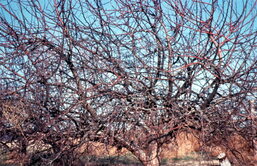
Often the best recommendation for such a tree is to make one pruning cut at ground level and start over with a new tree. However, trees may have sentimental value that will make revitalization worth the time and effort. Realize that this will be a multi-year process because no more than 30 percent of the tree should be removed in one year. Here are some steps to follow:
First Year:
1. Remove all dead wood. This does not count toward the 30 percent.
2. Remove suckers from the base of the tree.
3. Choose approximately six of the best branches to keep as scaffold branches. Remove all others.
Branches should be cut flush to the branch collar. The collar is the natural swelling that occurs where a branch connects to the trunk or to a larger branch. Removing the collar would leave a larger wound that would take additional time to heal.
Do not paint wounds. Wounds heal more quickly if left open.
Candidates for removal include branches with narrow crotch angles, which are more likely to break in wind and ice storms, and those that cross branches you will save. This may be all that is possible the first year if the 30 percent threshold has been reached.
4. Summer pruning should be done the first year as the tree will react to severe pruning. Specifically, the tree will likely produce numerous suckers and watersprouts. Remove all suckers (growth that arises from the base of the tree or from roots) as they appear during the growing season. Watersprouts are the growth that appears on major branches and grows straight up. These should be removed during the growing season as removing during the next spring will just encourage more watersprouts to appear during the growing season.
Second Year:
1. Thin the branches on each scaffold branch. Remove crowded branches to open up the tree to light and allow humidity to escape. Shorten each scaffold branch by cutting back to a side branch. When you are through, the tree should have enough wood removed so that a softball can be thrown through the tree.
2. Remove suckers and watersprouts as was done the first season. Removing water sprouts and suckers is the most time consuming and difficult practice necessary to bring an overgrown apple back into shape. (Ward Upham)
 RSS Feed
RSS Feed
